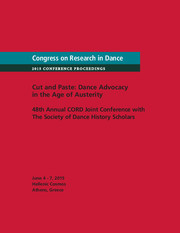No CrossRef data available.
Article contents
Moving Studies: Somatic-Performative Research in a Wide Dance Field
Published online by Cambridge University Press: 23 September 2014
Abstract
This is a presentation of the principles of somatic-performative research with application to the audience's research. The proposal has been developed over ten years of artistic-scientific research at the Graduate Program of Performing Arts of Federal University of Bahia, Salvador BA, Brazil. The approach associates Somatic Education and Performance in dance research, especially regarding inner impulse in relation to the environment and collective awareness in a micro-macro political attitude.
While quantitative and qualitative research deals with practice as an object of study, in performative research, practice is in itself a research method (Haseman 2006). Somatic-performative research is defined and organized by the somatic practice (“experienced body”), transforming the ephemeral nature of dance into the research's modus operandi. From the starting point of inter-artistic moving principles with/in the environment, the object of study becomes a creative, live, and relational subject. Therefore, studies and methods become contaminated by the subject's dynamic nature, melting any prejudice or a priori settings. In an unpredictable, autonomous, yet integrated, pulsing that destabilizes borders, discourses, and manners, dance becomes a spread-out medium of studies (rather than something to be studied).
As an integrated “soma,” dance research constantly dis-re-organizes “the way we form things,” subverting power relationships and discourses over art and the body. Somatic-performative exploration dilutes the separation and conflict between practice and theory, body and mind, art and science, dynamic multidimensional movement and fixed linear record, human and environment, place and non-place, matter and energy. In a connecting quantum spacetime, “being” is permanently perceived and reinvented as trans-cellular intelligence in movement or creative somatic wisdom in a “culture of becoming” with/in a “deep ecology.”
- Type
- Research Article
- Information
- Copyright
- Copyright © Ciane Fernandes 2014


